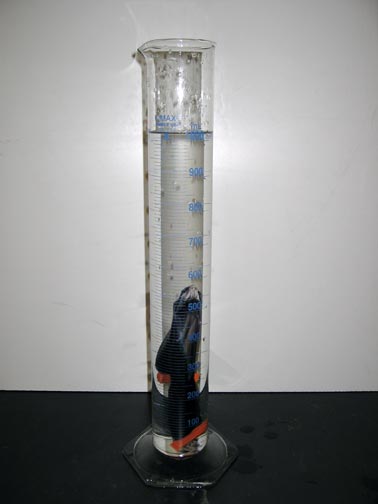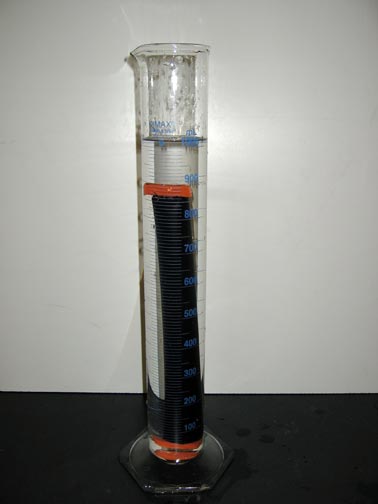Doing work with osmotic pressure

 A concentrated sugar solution is used to partially fill a membrane; when the membrane is immersed in pure water, the driving force of osmotic pressure swells the membrane to bursting.
A concentrated sugar solution is used to partially fill a membrane; when the membrane is immersed in pure water, the driving force of osmotic pressure swells the membrane to bursting.
Ingredients: dialysis membrane, fructose, stamp ink
Procedure: A complete recipe follows.
1. Partially fill a 30 centimeter dialysis tube with concentrated fructose solution, colored with stamp ink.
2. Seal the tube.
3. Immerse the limp tube in a graduated cylinder and cover with pure water.
4. Observe the membrane tube.
Understanding: The process of diffusion causes atoms and molecules to move about in chaotic trajectories. In time, a segregated mixture of gas molecules will mix so as to create a uniform concentration of each species. Similarly, in an aqueous solution the molecules of solvent and solute will diffuse so as to create a uniform concentration of each species.
When the species are not uniformly distributed, the system is not at equilibrium. It is only when the concentration of each species in the solution is uniform that the solution can be considered to be at equilibrium.
The driving force to create uniform concentrations of solute species is known as osmotic pressure. The magnitude of the osmotic pressure is given in terms of an equation of state in the form of the ideal gas law
π V = nRT
where π is the osmotic pressure, and n is the moles of solute particles in a volume V of solution. R is the universal gas constant, the use of which is by no means limited to gases!The ratio n/V is the concentration of solute particles, C. The osmotic pressure is proportional to the concentration of solute particles in solution
π = CRT
In exploring the properties of ideal gases, we found that by vaporizing a known mass of a compound, and measuring the resultant pressure in a container of known volume at a well defined temperature, it was possible to determine the molar mass of the compound. Given P, V and T, we can compute the number of moles, n. Given the mass of the gas and the number of moles, we can compute the molar mass.Similarly, the osmotic pressure can be used to obtain accurate estimates of molar masses of solutes dissolved in solution. It is more useful, for example, to determine the molar mass of a protein through the osmotic pressure than by trying to measure the pressure of a protein gas!
In our demonstration, the membrane is partially filled with a concentrated fructose solution marked with stamp ink. The semipermeable dialysis membrane allows water to pass through the membrane barrier, but does not allow fructose or ink to pass.
There is a strong osmotic pressure created within the membrane due to the fact that the concentration of fructose is much higher within the membrane than without. The diffusion of water into the membrane lowers the concentration of fructose. However, as the fructose cannot pass outside of the membrane the concentration of fructose outside of the membrane remains equal to zero.
Eventually, the pressure of the membrane holding the solution will be equal to the osmotic pressure driving additional water into the membrane. At that point, the system has reached equilibrium and the concentration of fructose within the membrane will remain constant.
Osmotic pressure and the molar mass of a protein
Question: Suppose 5.0 grams of the protein horse heart hemoglobin is dissolved in water to make a 1.0 liter solution. The osmotic pressure is measured to be 1.80 x 10-3 atm at 25C. What is the molecular weight of the horse heart hemoglobin protein?You can check your answers here.